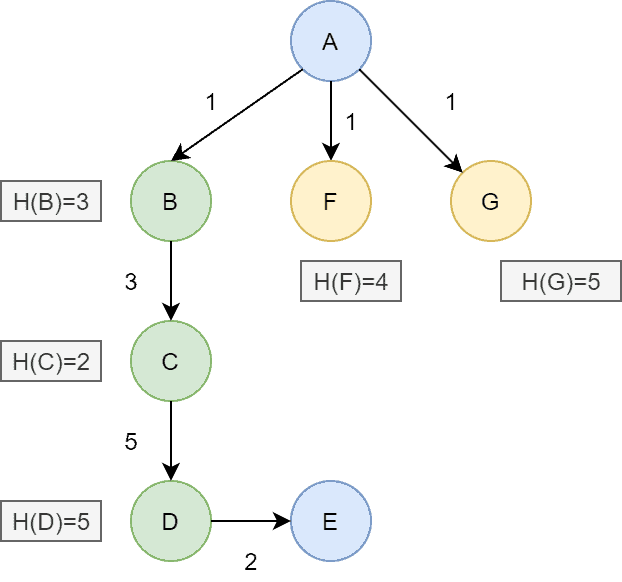1. 概述
在本篇文章中,我们将探讨两种在计算机科学和数学领域中广泛使用的算法设计策略:贪心算法(Greedy Algorithm) 和 启发式算法(Heuristic Algorithm)。
我们将介绍这两种方法的基本理论思想,并通过对比,总结它们之间的核心区别。
2. 贪心算法的理论思想
贪心算法主要用于解决最优化问题(Optimization Problems)。这类问题通常涉及对某个目标函数进行最大化或最小化。
贪心算法的核心思想是将问题划分为多个阶段(steps),在每一个阶段中选择当前最优的局部解(local optimal solution),并希望这些局部最优解能引导我们最终得到一个全局最优解(global optimal solution)。但需要注意的是,贪心算法并不保证最终结果一定是全局最优解。
✅ 优点:实现简单,效率高
❌ 缺点:不保证最优解,可能只能得到近似解
举个实际的例子:

假设 Jack 要去一个山区旅行,他希望选择一条费用最低且耗时最短的路线。他画出了所有可能路径的图,使用贪心算法来选择每一步的最优路径。
在这个例子中,Jack 可能会根据每小时平均费用(fare per hour)来判断当前最优路径。但这样做可能忽略后续路径的质量,比如某条路虽然便宜但危险,最终未必是最优选择。
常见使用贪心策略的经典算法包括:
- Dijkstra 算法(最短路径)
- Prim 算法(最小生成树)
- 背包问题(Knapsack)
- 数组中的最小最大值查找
3. 贪心算法失效的场景
虽然贪心算法效率高,但在某些问题中表现不佳。我们来看一个硬币找零的例子。
假设我们有以下面值的硬币:1、7、10,目标是凑出金额 15。
- 最优解:使用两个 7 和一个 1,总共 3 枚硬币
- 贪心解法:先选最大面值 10,再选五个 1,总共 6 枚硬币
这个例子说明:贪心策略在某些情况下会严重偏离最优解。
4. 启发式算法的基本原理
启发式算法用于快速设计出近似最优解。它不保证给出最优解,但能在较短时间内给出一个“足够好”的解。
它广泛应用于 NP 难问题(NP-Hard),如人工智能中的路径搜索、旅行商问题(TSP)等。
启发式函数(Heuristic Function)
在启发式算法中,每个节点都有一个启发值(heuristic value),用于估计该节点到目标的代价。启发函数可以分为两类:
- ✅ 可接受启发函数(Admissible):不会高估到达目标的实际代价
- ❌ 不可接受启发函数(Inadmissible):可能会高估代价
举个例子:

从 A 到 E 的实际代价是 11。图中 B、C、D 的启发值分别为 3、2、5,都小于实际代价,属于可接受启发函数。
常见使用启发式算法的算法包括:
- A* 算法(路径搜索)
- 模拟退火(Simulated Annealing)
- 爬山法(Hill Climbing)
- 遗传算法(Genetic Algorithm)
5. 启发式算法的权衡条件
使用启发式算法时,需要权衡以下因素:
- ✅ 问题是否属于 NP-Hard:启发式算法更适合这类问题
- ❌ 是否要求最优解:如果必须得到最优解,启发式不一定适用
- ✅ 时间效率是否优先:当经典算法太慢时,启发式是一个好选择
- ❌ 是否有多个可行解:启发式通常只返回一个解,无法遍历所有可能性
6. 贪心算法 vs 启发式算法的区别
| 特性 | 贪心算法 | 启发式算法 |
|---|---|---|
| 决策方式 | 每一步选择当前最优路径 | 使用启发函数评估所有节点,选择最优路径 |
| 时间复杂度 | 最坏情况下可能很高 | 通常控制在合理范围内 |
| 解的质量 | 局部最优,可能引导出全局最优 | 全局近似最优 |
| 是否有规则 | 没有固定规则,只选当前最优 | 有启发规则,引导到更优路径 |
7. 总结
本文我们介绍了贪心算法和启发式算法的基本思想,并通过实际例子展示了它们的优缺点。
| 算法类型 | 是否保证最优解 | 是否高效 | 适用场景 |
|---|---|---|---|
| 贪心算法 | ❌ 不保证 | ✅ 高效 | 简单优化问题 |
| 启发式算法 | ❌ 不保证 | ✅ 高效 | NP 难问题、AI、路径搜索 |
在实际开发中,选择哪种算法取决于问题的性质和对解的精度要求。对于复杂问题,通常结合多种策略,如使用启发式算法引导贪心策略,以达到更好的效果。